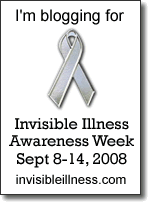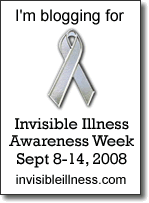 RSS FEED
RSS FEED
Posts Tagged ‘invisible illness’
Can You See my Pain? Can I See my Pain?
September 8th, 2008
It’s Invisible Illness Awareness Week, a worldwide effort to bring together people who live with invisible  chronic illness and those who love them.
chronic illness and those who love them.
According to the Invisible Illness Blog, nearly 1 in 2 Americans have some kind of chronic illness. From heart disease to mental illnesses, cancer, lupus, chronic fatigue, Migraine and headache disorders and many others, people are suffering all around. While our illnesses may be invisible, giving no outward visual signs, why are they so unknown to those around us?
The statistics on Migraine disease are staggering.
- About 12% of the human population has Migraine disease (at any given time). That’s about 1 out of every 8 people you know.
- About 20% of the human population will have Migraine disease at some time in their lifetime (since it may develop in childhood, adolescence or adulthood, and since it sometimes fades or disappears with age). That’s about 1 out of every 5 people you know!
- About 47% of Migraineurs have 3 or more Migraine attacks per month. That’s about 1 out of every 17 people you know!
Given those numbers, why is this disease so misunderstood, un-researched, underfunded, and the treatment options so undeveloped? Why do so many people, even doctors, think it’s “just a headache”? There’s enough for several more posts in answer to that question, but I think invisibility is one of the major reasons.
 Think about the invisibility of head pain. Unless someone is highly attuned to changes in our eyes and expressions, or the cue of hand to forehead, they will not know when we have a Migraine attack. It’s not like they can see the hammer knocking us on the head! Even more significantly, perhaps, it’s hard for others to understand how we might feel fine today, but be unable to get out of bed tomorrow. It’s hard to understand the long term consequences of frequent or chronic pain. Migraine can increase stroke risk, and Migraine disease can cause brain damage over time: this is recent knowledge.
Think about the invisibility of head pain. Unless someone is highly attuned to changes in our eyes and expressions, or the cue of hand to forehead, they will not know when we have a Migraine attack. It’s not like they can see the hammer knocking us on the head! Even more significantly, perhaps, it’s hard for others to understand how we might feel fine today, but be unable to get out of bed tomorrow. It’s hard to understand the long term consequences of frequent or chronic pain. Migraine can increase stroke risk, and Migraine disease can cause brain damage over time: this is recent knowledge.
There is much we can do to educate others, to explain to those around us, to rally for more research, to insist on accommodations at work and adequate treatment from doctors, emergency rooms, and insurance companies. But I think one foundation of the problem lies in how invisible this illness even to ourselves.
Last week I practiced saying “I am chronically ill.” I said it to a number of different people, and told it to myself in the mirror. Big deal? It is a big deal. It is the reality of my life for most of the last 13 years, yet I have a very hard time accepting it. I am a meticulous record keeper. I keep a very detailed Migraine and Wellness diary where I track not only Migraines but my sinus infections, my fatigue, and my dizziness, among other things. I can tell you that over the past 4 years, I have been sick, with my ability to function significantly reduced, 25% of the time. It’s probably higher than that, because I have a lot of Migraines in the evening, but if I have worked and functioned most of the day, I have counted that as a well day.
I am one of the lucky ones. Many chronically ill people are sick more than half the time. Since I am in business for myself, I can set my work up to be flexible and take the time I need for myself. My ability to meet deadlines and my income do suffer. Imagine having a job, and needing to take 6 sick days per month. That’s what my numbers translate to.
Those are the facts, and yet it is very hard to accept that I am chronically ill. If you’re not sick every day, it’s easy to fall into denial again. To forget that there are limitations to what I can do. That even when I feel great I need to be very cautious and marshal my energy. That things I used to do are not
available to me any more. That I need to adjust the standards I have measured myself by.
I need to be as kind, forbearing, patient, understanding and loving towards myself as I would be to a friend who was chronically ill. Why is that so hard? I need to accept where I am without giving up hope, and while still striving to take better care of myself, get better treatment, do everything I can to be as well as I can be.
When I am caring for myself in this way (and I do manage it at times), it is easier for me to be real with the people around me. To explain my illness, to help them understand. I need to have my illness visible to me; then I can help make it visible to others.
– Megan Oltman
Tags: chronic illness, invisible illness, migraine
Posted in Advocacy, Communicating, Managing | Comments (2)
Blogging for Invisible Illness Awareness Week
August 31st, 2008
 Coming soon – I will be doing a post on Migraine disease as an invisible illness for Invisible Illness Awareness Week, Sept 8-14, 2008. Please visit the Invisible Illness Awareness Week Blog for lots of great posts on what it means to have an invisible illness – one that effects your life and abilities, that others cannot see. I’ll be posting on the topic on September 8, along with lots of other bloggers on that day. If you’d like to join in, visit the blog link above.
Coming soon – I will be doing a post on Migraine disease as an invisible illness for Invisible Illness Awareness Week, Sept 8-14, 2008. Please visit the Invisible Illness Awareness Week Blog for lots of great posts on what it means to have an invisible illness – one that effects your life and abilities, that others cannot see. I’ll be posting on the topic on September 8, along with lots of other bloggers on that day. If you’d like to join in, visit the blog link above.
What can we do about our invisible illness? Nancy Bonk had the great idea of wearing a big bandaid across our foreheads – to make our disease visible. I’m thinking maybe a baseball cap with a bandaid embroidered right across the front – “Migraine Disease and Headache Disorders – Invisible No More.” What do you think? Would you wear one?
– Megan
Tags: chronic illness, headache disorders, invisible illness, Migraine disease
Posted in Advocacy, Weblogs | Comments (5)
Coming Out of the Migraine Closet
April 18th, 2008
When someone comes out of the closet, they take a stand, and they take a risk. For centuries, gay and lesbian people hid their identities in order to survive. Then a few people said “no more.” Decided to risk public censure, job loss, jail, so that things could change. And things have changed. Dramatically. There is still risk involved in coming out as a gay, lesbian, bisexual or transsexual  person, significant risk, but there has also been a significant change in our society around this issue.
person, significant risk, but there has also been a significant change in our society around this issue.
Are we willing to “come out” as migraineurs? Are we willing to tell people we have Migraine disease? To stop complaining about lack of understanding and take a stand, educate people? Are we willing to stand up and be counted – “I’m one too!” – and change the face and the perception of this disease? I thank the GLBT movement for an extremely useful analogy.
Sometimes we need to vent about how people see our condition as “Just a Headache” or “All in Your Head.” I have done my share of ranting on this point. We don’t want to have to educate people. It’s really not fair to have all this pain and have to explain it as well! (Do you hear your Mom’s/Dad’s voice in your head, like I do, saying “but life’s not fair!”) I also know it’s hard to show up as someone with a disease. A diseased person. A disabled person. A limited person. We don’t want the world perceiving us this way. Perhaps more significantly, we don’t want to think of ourselves this way.
Diseased, disabled, limited – these are common, automatic perceptions of those with visible illnesses. Being “in the closet” is not an option with a visible illness. Here again, the amazing and courageous movement for the rights of disabled people has changed public perception. The acceptance and  accommodation of those who are differently-abled has come a long way, though there is still much further to go.
accommodation of those who are differently-abled has come a long way, though there is still much further to go.
The blessing and curse of invisible illness is that it is invisible. No one can look at me and see that I have Migraine disease. If they are very perceptive, they might see that something is wrong if I’m in the midst of a migraine. No one can look at me and see that I have chronic fatigue. Sometimes they can see that I look very tired. No one can look at me and see that I have chronic sinus infections. Sometimes they can hear my hoarseness or congestion.
I think we all know what the curse of invisibility is. People do not understand our pain. They sometimes belittle it. Our employers may not accommodate us. Public events are not set up to make it easy for us to be there. Our dearly loved friends and family may think we are avoiding them, shirking responsibility, failing them. In a larger sense, invisibility means our diseases are under-funded, under-researched, medications are inadequate and specialists too few.
So what’s the blessing? When our disease is invisible, we can keep trying to show up as “normal.” We can avoid having potentially unpleasant conversations. We can avoid pity and put-downs. Of course, it’s a mixed blessing because people do see that something is wrong. I suspect some of the put-downs come from people seeing something is wrong but not knowing what it is. I think I’d rather be seen as someone with a chronic illness that interrupts my life, than as a messy flake who can’t be counted on to show up!
We need to remember that we migraineurs are 12% of the population. 12 out of every 100 people. 3 out of every 25! Whoever you are talking to, chances are they know many, many migraineurs besides you! Even more significantly, according to some estimates, 40% of Americans have some kind of chronic, invisible illness. Whoever you are talking to, they have people very close to them with invisible illness!
Lately I have been way out of the closet as a migraineur. I am in this public forum, all over the web with my real name, as a migraineur. I have gone to my business contacts and talked to them about the work I am doing as a Migraine management coach – and telling them that has involved sharing something of my personal story. I am someone with chronic illness who has built a business around my illness. I help others build workable lives around their illnesses. I can’t do that while hiding who I am.
These days when I show up at my business networking meetings, people ask me, with great concern, “how ARE you?” I told an associate recently, “feeling great today!” He breathed a little sigh of relief and asked “So your migraines are all gone?” (Hey, wouldn’t that be nice?) He wanted me to be better! It’s the kind of reaction I’ve been avoiding for years. “No,” I said, “it’s a chronic disease. It’s the way my nervous system is made. I wish they were all gone. But today I’m feeling great!” He nodded, I shrugged, and we went on to talk about something else.
A few months ago I couldn’t have had that conversation. For now, I keep showing up, assuming that people are not malicious, they are just uninformed. And I inform them. Gently, and as appropriate. They ask me what I’m doing these days and I tell them I’m focusing on helping people with  Migraine, people like me.
Migraine, people like me.
So hey, migraineurs, are you willing to come out and play, out here with me, out of the closet? I’d love to have your company. We can change public perception. We can create a world more responsive to our needs, more accepting of who we are.
– Megan Oltman
Don’t forget your sunglasses, it’s bright out here!
Closet image courtesy of Matthew Blank
ADA Road to Freedom image courtesy of Jay Wilson
Cave exit image courtesy of David Wilmot
Tags: Advocacy, Americans with Disabilities Act, Coming out, disability, invisible illness, Migraine disease, migraineurs
Posted in Advocacy, Communicating, Musings | Comments (7)
That disclaimer thing...
Remember: nothing we do here is medical advice or treatment or is a substitute for medical advice or treatment. Get competent medical advice to learn more about your migraines, possible treatments and risks.
What's New on Migraine Support Group Coaching |
Recent Comments
- on Calling all Redheaded Migraineurs
- on No, You’re not Crazy, You just Have Migraines
- on No, You’re not Crazy, You just Have Migraines